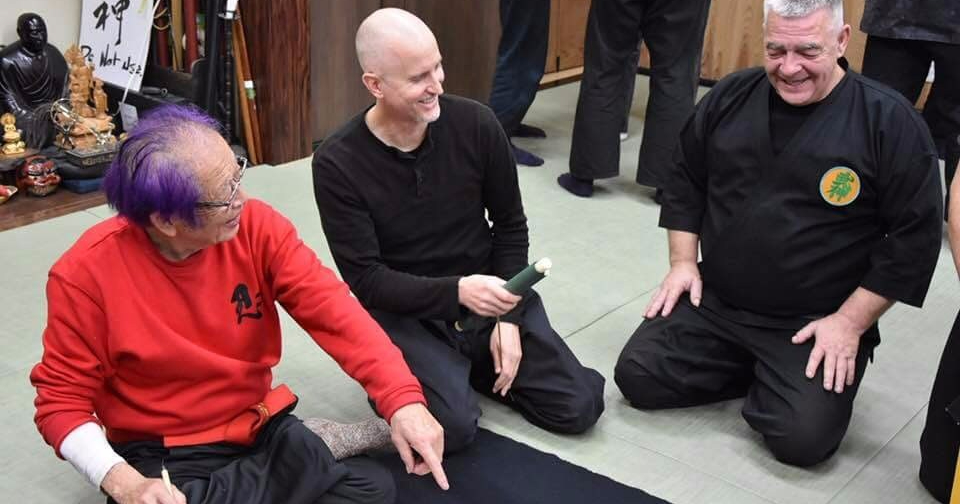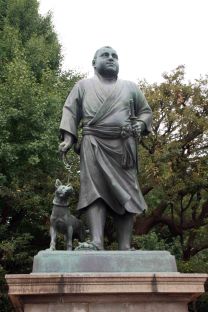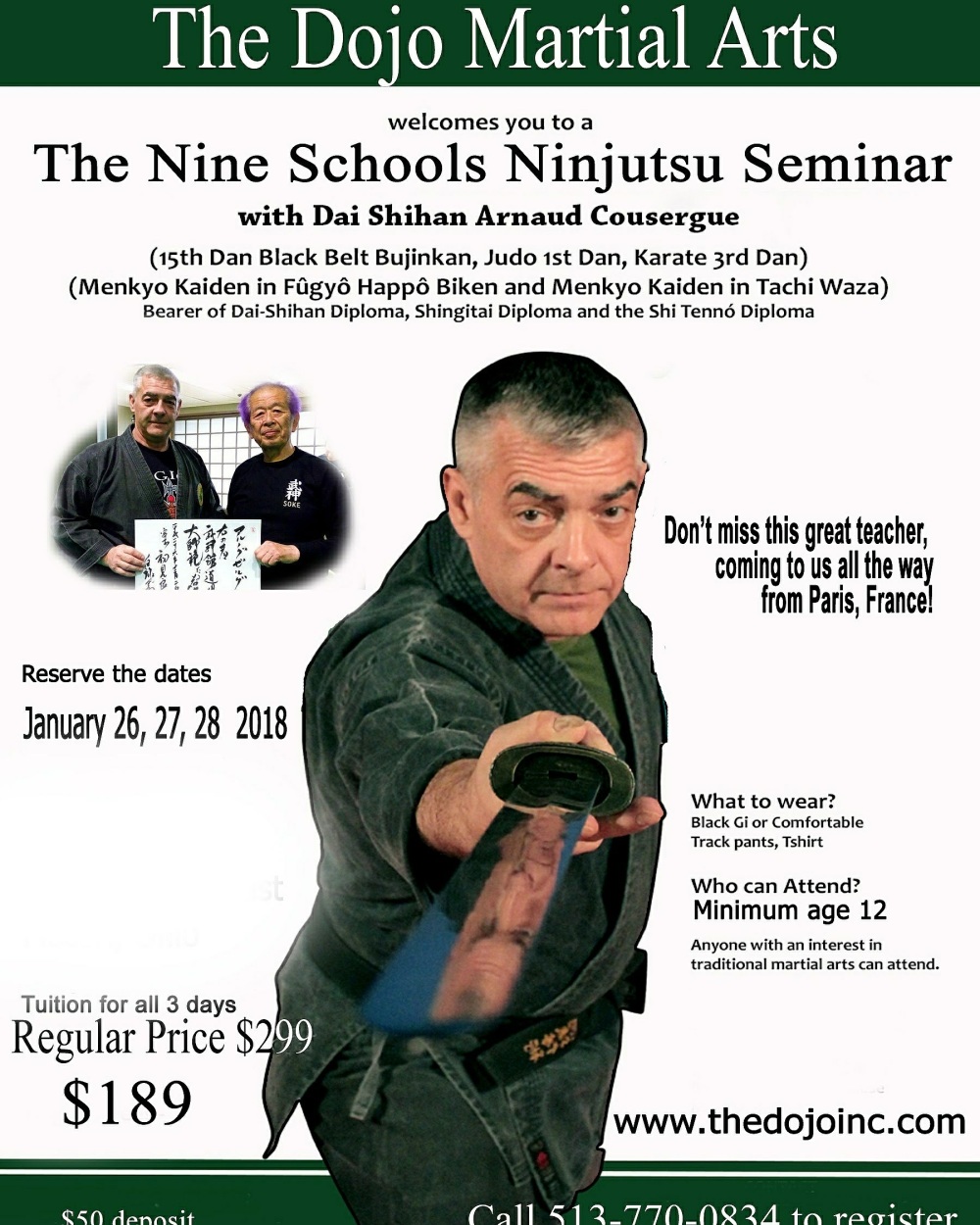Be Like A Butterfly!
From Shiro Kuma by kumablog
 During Friday’s class, I asked Sensei to write: “It is not about fighting, it is about controlling.” What I got was “Chochō Hanami Maai” or “Butterfly, flowers, distance.” (1)
During Friday’s class, I asked Sensei to write: “It is not about fighting, it is about controlling.” What I got was “Chochō Hanami Maai” or “Butterfly, flowers, distance.” (1)From Shiro Kuma by kumablog
 During Friday’s class, I asked Sensei to write: “It is not about fighting, it is about controlling.” What I got was “Chochō Hanami Maai” or “Butterfly, flowers, distance.” (1)
During Friday’s class, I asked Sensei to write: “It is not about fighting, it is about controlling.” What I got was “Chochō Hanami Maai” or “Butterfly, flowers, distance.” (1)From Shiro Kuma by kumablog

The more I train here, and the more I am lost.
Only a few days left to get 33% discount on all DVDs at www.budomart.com
From Bujinkan Santa Monica by Michael
 |
| shrine to 蔵王権現 Zaō gongen. photo by Michael Glenn |
From Budoshop by BUDOSHOP.SE
This was filmed in Australia in the middle of Mats Hjelm’s #JapanTrip38.
The instructions on this film is in English. Each technique is demonstrated several times from all angles. The techniques are a mix of basics and new techniques from Japan trainings this year.
On Saturday the training started with all three forms in Sanshin no kata, then moved on to Muto-dori. Muto-dori and especially Shinken-shiraha-dome is this years theme in Japan, it is unarmed defence against knife and sword where you grab the blade.
Sanshin Gokei no kata (5 techniques)
Sanshin Gogyo no kata (5 techniques)
Sanshin Goshin no kata (5 techniques)
Sanshin with Kunai (5 techniques)
Muto-dori and Taijutsu (many techniques)
On Sunday the training started with Ashirau with is techniques trapping his legs and take him down. Then Taijutsu and Muto-dori against sword and knife was taught. Finally the five Jutte techniques from Kukishin-ryu was taught.
Ashirau (4 techniques and henka)
Muto-dori and Taijutsu (many techniques)
Jutte-jutsu (5 techniques)
The video is edited down to 62 minutes
Some of the people was at the seminar and requested more Ashirau techniques and Jutte techniques. A little Kunai was taught and also Muto-dori and Taijutsu.
The video is edited down to 17 minutes.
Taijutsu and Muto-dori was taught at this extra training.
The video is edited down to 27 minutes.
Title: Down under in Australia with Mats Hjelm
Instructors: Mats Hjelm
Theme: Sanshin no kata, Kunai, Jutte, Muto-dori
Recorded: Recorded in Port Macquarie, Newcastle and Sydney, Australian October 2017
Kind: Apple MPEG-4 movie
Size: 5 703 149 641 bytes (5,7 GB on disk)
Dimensions: 1280×720
Codecs: H.264, AAC, Photo – JPEG, QuickTime Text
Duration: 106 min…
From Shiro Kuma by kumablog
From Shiro Kuma by kumablog

I began training in June 1984. This year it is my 33rd year in the Bujinkan. With Christmas coming soon, I thought it would be nice to celebrate this anniversary together.
During the whole month of November, you get a permanent discount of 33% on ALL budomart DVDs. That is my way of thanking you for being in my life.
You can use this discount only once, so, choose wisely. 
Get your DVDs today and be sure to have them waiting for you under the Christmas tree!

From Shiro Kuma by kumablog

There is a new painting of Saigō Takamori in the Dōjō from the Edo period. (1) (2)
Saigo Takamori helped to replace the Bakufu to install the Meiji restoration.
During the Boshin war (1868-1869), Saigō Takamori led the Meiji army. Disagreeing on the reforms put in place by the new power, he left the court and went back to Kagoshima in Satsuma. As a clan leader, he was right to his people, he rebelled to the Meiji power and went to war against troops of the emperor. These events are called the Satsuma rebellion.
In the end, surrounded by the imperial troops, injured, he committed seppuku in 1877. He was 49-year-old.
Sensei explained that Saigō was unlucky.
These were difficult times of change. The official start of the Meiji restoration is 1868, but this didn’t happen overnight. In fact, the end of the Satsuma rebellion of 1877 is the real beginning of the Meiji era.
He was pardoned in 1889, and he is considered today a significant historical figure of Japan. Today you can see his statue facing the parliament in Tōkyō.
Considered “the last Samurai” by many, his luck left him. As Hatsumi sensei often repeats, “to succeed, you need to be lucky. Create your chance.”
For Western minds, it is strange to consider that chance can be created. But when I look at my life in the Bujinkan for the last 33 years, I understand what sensei means. Last Sunday, Sensei added that “if you want to live a long time you need to have luck!”
Train sincerely and the Bujinkan arts will help you to get lucky, unlike Saigō Takamori.
_______________________
1. Saigō Takamori: (西郷 隆盛 (隆永), January 23, 1828 – September 24, 1877)
2. https://en.m.wikipedia.org/wiki/Saig%C5%8D_Takamori
3. Boshin wars; https://en.wikipedia.org/wiki/Boshin_War
4. Wikipedia: “…Unable to overcome the affection that the people had for this paragon of traditional samurai virtues, the Meiji Era government pardoned him posthumously on February 22, 1889.”
From Shiro Kuma by kumablog
The waves keep crashing on the shore, they change to adapt, but they are all the same. Water flows on what it finds on its path.
“Intelligence is the ability to adapt to change,” said Stephen Hawking. That is what we learn in the Bujinkan.
A friend in Japan noted that Sensei always finished his sentences by “Demo” (however). Sensei leaves all his answers unfinished. (1)It reminds me of the concept of Chūtō Hanpa, (2) where you do NOT finish the technique.
It is easy to understand it in a fight where many right solutions are possible. There are many ways to adapt to a given attack. But it seems more difficult to apply it on a daily basis. Our problem is that we are too judgmental. We always an opinion about everything. Sensei doesn’t have any firm position. He never closes the door, and never get things fixed permanently.
His answers are flows of possibility fitting the moment. All through these last thirty years, I often saw it. One day Sensei would answer a specific question. Two years later, he would give a different answer to the same problem. The first time, I thought my memory was defective. But when the same occurred many times, I began to believe that he is only adapting his answer to the moment. There is no truth, the only possible course of action is to adapt.
In life, as in technique, there is no right or wrong answer. There is only a flow of opportunities leading into one direction or another, both being good. In one of his book, he wrote: “[…] you must know when to bend with the wind, and know that there is no need to bend when there is no wind.” Later he adds “[…] If you ask if there is truly such a thing as the fundamental techniques of ninjutsu, we will have to say “no.” If you ask if you are doing the fundamentals correctly, we will tell you that there is no right or wrong way. These movements we call the fundamentals are only a means for the attainment of the natural-appropriate responsive movement that comes with personal enlightenment.”
Strangely in the text above he keeps letting things open, one moment there are no fundamentals, the next sentences he says there are no right or wrong to do these fundamentals! This the “Demo” attitude that is so characteristic of Sensei’s personality.
The Bujinkan is not about learning hundreds of Waza, it is about being able to adapt, to not be judgmental, and to be happy, Demo…
__________________________________________
1.Demo: でも, but; however; though; nevertheless; still; yet; even so; also; as well
2. Chūtō Hanpa: 中途, in the middle; half-way + 半端, fragment; fraction; halfway
Cincinatti, Ohio January 2018

From Bujinkan Santa Monica by Michael
 | |
| Hatsumi Sensei and Michael Glenn |
“Don’t do more than necessary by grabbing. But trying NOT to grab is also doing too much. you have to be in the middle. that middle space is where you can disappear.”What does this type of control look like? Well, I just felt it and witnessed it in the Bujinkan Honbu dojo. The opponent ends up fighting himself. Soke was doing this against knife attacks. And every time the attack came in, Soke pivoted around it and was able to redirect the knife so the attacker stabbed or cut himself.
From Kasumi An Study Center 霞庵 スタディセンター by カスミアン
By Tomoe Gozen
Take a look out the window tonight(October 4th) and you will see the Chushu no Meigetsu. The Japanese have an ancient tradition of gazing at this moon on this particular date. They like to eat snacks, sing songs and quietly contemplate.
According to the lunar calendar, Chushu, 中秋 which means in the middle of autumn, was the 15th of August. They also call this moon Juugoya, 十五夜、 the night of the fifteenth. It used to always be a full moon but since the Japanese no longer use the lunar calendar, sometimes it is not completely full. But if you have not taken some time to look at the moon recently, dont miss this opportunity to slow down and enjoy some nature beauty and moon rays. You will be glad you did!…